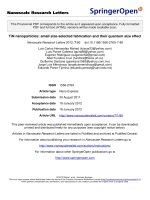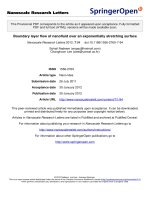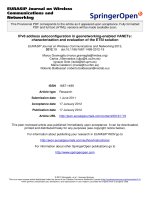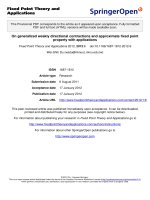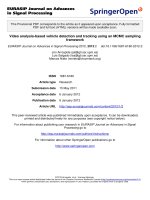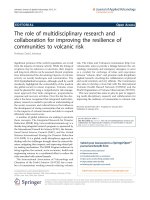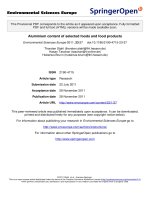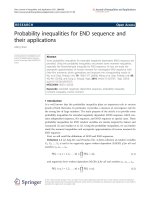Báo cáo toán học: " TiN nanoparticles: small size-selected fabrication and their quantum size effect" doc
Bạn đang xem bản rút gọn của tài liệu. Xem và tải ngay bản đầy đủ của tài liệu tại đây (1.06 MB, 22 trang )
This Provisional PDF corresponds to the article as it appeared upon acceptance. Fully formatted
PDF and full text (HTML) versions will be made available soon.
TiN nanoparticles: small size-selected fabrication and their quantum size effect
Nanoscale Research Letters 2012, 7:80 doi:10.1186/1556-276X-7-80
Luis Carlos Hernandez Mainet ()
Luis Ponce Cabrera ()
Eugenio Rodriguez ()
Abel Fundora Cruz ()
Guillermo Santana ()
Jorge Luis Menchaca ()
Eduardo Perez-Tijerina ()
ISSN 1556-276X
Article type Nano Express
Submission date 30 August 2011
Acceptance date 18 January 2012
Publication date 18 January 2012
Article URL />This peer-reviewed article was published immediately upon acceptance. It can be downloaded,
printed and distributed freely for any purposes (see copyright notice below).
Articles in Nanoscale Research Letters are listed in PubMed and archived at PubMed Central.
For information about publishing your research in Nanoscale Research Letters go to
/>For information about other SpringerOpen publications go to
Nanoscale Research Letters
© 2012 Mainet et al. ; licensee Springer.
This is an open access article distributed under the terms of the Creative Commons Attribution License ( />which permits unrestricted use, distribution, and reproduction in any medium, provided the original work is properly cited.
TiN nanoparticles: small size-selected fabrication and their quantum size effect
Luis Carlos Hernández Mainet
*1,2
, Luis Ponce Cabrera
1
, Eugenio Rodriguez
1
, Abel Fundora
Cruz
2
, Guillermo Santana
3
, Jorge Luis Menchaca
4
, and Eduardo Pérez-Tijerina
4
1
Laboratory of Laser Technology, CICATA-IPN, Altamira, Tamaulipas, 89600, Mexico
2
Instituto de Ciencia y Tecnología de Materiales (IMRE), Universidad de La Habana, La
Habana, 10400, Cuba
3
Instituto de Investigaciones en Materiales, Universidad Nacional Autónoma de México,
CP 04510, Coyoacán, México
4
Centro de Innovación, Investigación y Desarrollo en Ingeniería y Tecnología (CIIDIT),
Universidad Autónoma de Nuevo León, Monterrey, Nuevo León, CP 66450, México
*Corresponding author:
LCHM:
LPC:
ER:
AFC:
GS:
JLM:
EPT:
Abstract
Size-selected TiN nanoclusters in the range of 4 to 20 nm have been produced by an
ionized cluster beam, which combines a glow-discharge sputtering with an inert gas
condensation technique. With this method, by controlling the experimental conditions, it
was possible to produce nanoparticles with a high control in size. The size distribution of
TiN nanoparticles was determined before deposition by mass spectroscopy and confirmed
by atomic force microscopy. The size distribution was also analyzed using a high-
resolution transmission electron micrograph. The photoluminescence [PL] spectra of TiN
nanoparticles at different sizes were also experimentally investigated. We reported, for the
first time, the strong visible luminescence of TiN nanoparticles on Si (111) wafer due to the
reduced size. We also discussed the PL intensity as a function of the nanoparticle size
distribution.
Introduction
Metal nanoparticles 1 to 100 nm in size and 10
2
to 10
8
atom aggregates (known as clusters)
have demonstrated different physical-chemical properties from their bulk. The reasons for
these properties can be attributed to the large portion of surface atoms and quantum size
effect, which is caused by the reduced size in three dimensions. When the cluster is very
small, the number of atoms at surfaces or grain boundaries is comparable to the number of
atoms in the crystalline lattice. Also, with the decrease of the cluster size, the electronic
properties start to change. This effect is called the ‘quantum confinement effect’, which can
be observed as a shift in the optical bandgap or exciton energy depending on the
nanoparticle diameter. Several investigations have been carried out to study the particle size
effects on their physical-chemical properties. A typical example is that the melting
temperature of nanoparticles strongly depends on the size and shape and is substantially
lower than the bulk melting temperature [1-3]. For nanoscience, the study of size-selected
nanocluster is very important to understand the fundamentals of solid physics in a
nanometric scale because it is the bridge in the gap between individual atoms and
condensed matter.
Metal nanoparticles are used in a broad spectrum of applications such as in biomedicine
[4], optoelectronics [5], solar cells [6], and anti-wear coatings [7]. Nowadays, they are
involved in many products and applied in several technologies. Most metal nanoparticles'
production processes require a precise control of narrow range size. In particular, especial
conditions are necessary to produce very small size-selected nanoparticles at an industrial
scale [8]. From a technological viewpoint, metal clusters can be regarded as the precursors
to a new generation of nanostructured materials and devices. The fabrication of
nanoparticles by controlling their size and shape is one of the challenging tasks for
nanotechnology.
Among different techniques to obtain nanoparticles, ionized cluster beam deposition
[ICBD] has been receiving great attention due to its control of size-selected nanoparticles
[9]. The novel technique combines plasma sputtering and gas aggregation to produce
nanoclusters from a few atoms to a few thousand atoms. The general setup of this system
includes magnetron sputtering, a cluster aggregation zone, a mass filter, and a deposition
chamber. Using a magnetron discharge, hot atoms are generated by Ar
+
bombardment on
the target surface. The atoms are cooled and condensed in a cold inert gas to create the
clusters. The cluster size can be controlled by adjusting the sputter yield, gas pressure,
volume of the cluster growth region, and bias voltage. A mass filter located along the
central axis of the system allows for selection of the cluster size. The clusters are
accelerated toward the substrate surface by a bias voltage application. Finally, clusters join
together, whether during the flight to the substrate or at the target surface, to form the
nanoparticles.
Titanium nitride [TiN] has been generally applied in industrial coatings with high demands
on hardness and adhesion as well as high thermal stability and good conductivity [10]. Due
to this important feature, TiN has been widely used as a hard and protective coating for
cutting tools or in electronic devices. Based on the properties of the bulk materials, TiN
nanoparticles are being used as an additive element in protective coatings to enhance the
adhesion properties [11] and a catalyst support material for noble metals for application in
PEM fuel cells [12]. Several techniques, both chemical vapor deposition and physical vapor
deposition, have been used to deposit TiN coatings. However, the industrial production of
TiN nanoparticles is still beginning to take its first steps. ICBD is one technique that can be
applied to produce TiN nanoparticles [13-16]. The investigation of TiN nanocluster
deposition by ICBD can help to improve the production of nanomaterials and to understand
their physicochemical properties at a nanoscale.
The fabrication of nanoparticles is an elaborate procedure. The following characterization is
a complex but important task. Atomic force microscopy [AFM] and high-resolution
transmission electron microscopy [HRTEM] have demonstrated to be powerful techniques
to determinate the size of nanoparticles below 10 nm [17, 18]. In addition,
photoluminescence [PL] spectroscopy has emerged as an important tool for studying the
luminescence of nanoparticles. The origin of such luminescence is often associated to
quantum confinement effects in which the position of the PL energy peak depends
fundamentally on the nanoparticle size.
In this paper, TiN nanoparticles with a narrow-sized range are deposited on Si (111)
substrates at room temperature by ICBD method. The size distribution of the TiN clusters is
measured before deposition by mass spectrometry and after by transmission electron
microscopy [TEM] and AFM techniques. The crystalline structure of the TiN nanoparticles
is further confirmed by the micrograph fast Fourier transform [FFT] analysis. A statistical
detailed analysis of the TiN nanoparticle size distribution as a function of bias voltage is
performed by HRTEM. The PL spectra of TiN nanoparticles at different sizes are also
investigated experimentally. We reported for the first time, the strong visible luminescence
of TiN nanoparticles on Si (111) wafer due to the reduced size.
Experimental details
Cluster production and co-deposition
A NanoSys 500 deposition system, built by Mantis Deposition Ltd (Thame, Oxon, UK),
was used to produce size-selected TiN nanoclusters [19]. Figure 1 shows a schematic
diagram of the experimental setup. The fabrication of noble metal nanoclusters using
Nanosys 500 has been described elsewhere by other authors [18]. The difference in
producing TiN clusters is the use of a reactive gas (N
2
) aggregation process.
Inside the cluster generation zone, the TiN clusters were produced by sputtering a Ti target
in an inert gas atmosphere of Ar
+
and by adding directly over the sputter target a small flux
of nitrogen gas (20 sccm). When the Ti target is sputtered, the clusters are formed by
multiple collisions between the high-density particles (sputtered particles and also argon
and nitrogen gasses). During cluster formation, the sputter chamber is kept at a low
temperature by a coolant mixture (2°C), and the pressure was set at 1 × 10
−4
Torr. The
residence time within the aggregation zone can be diversified by varying the length of the
aggregation region with the linear motion drive. The cluster size can be controlled by
varying the principal parameters: the sputter power, flow of gasses, and the aggregate zone
length (variable using a linear drive). The clusters flow together with the argon gas through
a variable orifice towards a mass filter. The mass distribution is monitored in situ by a
MesoQ mass filter (Mantis Deposition LTD, Thame, Oxon, UK) before the deposition. This
mass filter has been specifically added for the purpose of high-resolution measurement and
filtering of nanoclusters between 1 × 10
3
and 3 × 10
7
amu. A typical mass distribution
spectrum of the obtained TiN
+
clusters is presented in Figure 2. The mean cluster diameter
was estimated from the cluster masses by using the specific density and the molar volume
of the TiN.
Once the size clusters are selected by the MesoQ mass filter, they are accelerated by
applying a bias voltage (V
b
) to a substrate in a high vacuum with a base pressure of 10
−8
Torr. The nanoparticles were deposited onto silicon wafer. The substrates were cleaned in
successive ultrasonic baths of acetone and isopropyl alcohol. The depositions were
performed at room temperature without any heating and were applied different bias
voltages (3 and 6 kV). The nanoparticle size was controlled by regulating the magnetron
power, gas flow (Ar and N
2
), and aggregation zone length. These parameters were varied to
produce particles of different sizes onto the substrate.
Characterization of TiN nanoparticles
The size distribution and morphological characterization were performed by AFM analysis,
using a (Veeco Instruments Inc., Plainview, NY, USA) multimode scanning probe
microscope in hard tapping mode. The sample surface was scanned at 1 Hz and within 1
µm
2
. The Image Processing and Data Analysis software (Version 2.1.15) by TM
Microscope (Camarillo, CA, USA) was used for image analysis.
For TEM characterizations, TiN nanoparticles were grown on copper grids. Samples were
characterized by HRTEM using a 300-kV FEI Titan 80-300 STEM/TEM microscope (FEI
Co., Hillsboro, OR, USA). The HRTEM images were used to study the TiN crystalline
structure by micrograph FFT analysis. A detailed statistical analysis of TiN nanoparticles
after deposition was performed by measuring several hundreds of nanoparticles using the
HRTEM micrographs. The size distribution, the nearest neighbor distance (d
NN
), and the
covered area on the surface were extracted from these calculations. The procedure was
carried out by manually outlining the particles from several dozens of low- and high-
resolution TEM images. Once digitized and saved in the proper format, the image was
processed using the Gatan Digital Micrograph and Mathematical software (Gatan, Inc.,
Pleasanton, CA, USA).
PL studies were carried out at room temperature in a conventional PL system. An He-Cd
laser (λ = 325 nm at 16 mW) was employed as the excitation source. The outgoing radiation
from the sample was focused on the entrance slit of a 50-cm Acton monochromator
(Princeton Instruments, Trenton, NJ, USA). The detection was carried out using a Princeton
Instrument photomultiplier tube to a photon counter. All the spectra were corrected for the
spectral response of the system.
Results
Size distribution of TiN nanoparticles
Figure 3 displays the typical size distribution recorded by the mass filter for three samples
containing nanoparticles with different diameters. The mean nanocluster diameter was
obtained after fitting a Gaussian function to the experimental data (Figure 3, solid lines).
The figure displays the nanoclusters having a narrow size distribution of 4.1, 5.3, and 7.1
nm with a full width at half maximum of 1.2, 1.4, and 2.1 nm, respectively. Moreover, a
good separation of peaks is clearly observed demonstrating that the mass filter can resolve
the nanoparticle diameter with a difference at approximately 1 nm. Hence, the filtering
process allows the selection of particles with a high resolution in size higher than 1 nm,
which could be used in either scientific research or technological development. Varying the
critical parameters on the system (gas flow, partial gas pressure, magnetron power,
aggregation zone length), we were able to produce small nanoparticles at different sizes:
4.1 ± 0.2, 5.3 ± 0.4, 6.2 ± 0.2, 7.1 ± 0.3, 14.9 ± 0.7, and 20.3 ± 0.8 nm.
After the deposition of TiN nanoparticles on Si (111) wafer, the morphology and size
distribution were analyzed using the AFM images. Figure 4 shows a typical AFM image of
TiN nanoparticles. From the figure, it is possible to observe the aggregation of
nanoparticles, which could be explained due to clusters landing on top of each other before
the layer is completed. For longer deposition times, it is expected that even more clusters
get aggregated. The magnification in Figure 4a,b was used to measure the height profiles of
four nanoparticles (Figure 4c). The height shows a roughly Gaussian profile, which allows
to consider the nanoparticle as quasi-spherical.
AFM height histograms for TiN nanoparticles at different filtered sizes are shown in Figure
5. These histograms show narrow height distributions with averages of 15.5 nm (Figure 5a)
and 23.0 nm (Figure 5b). Usually in an AFM measurement, the distance in the z-axis is
directly related to the nanoparticle size. However, in the xy plane, the distance is enlarged
regarding the real spatial dimensions because the width of the AFM tip is distorted by the
combination of the nanoparticle shape and tip geometry. In this case, the widths of height
histograms do not refer to the real sizes of nanoparticles. Therefore, the results of size
distribution for both mass filter and AFM height profiles support the effective mass filter to
control the TiN nanoparticle size.
The nanoparticle size was directly measured by HRTEM micrograph. Figure 6 shows TiN
nanoparticles with sizes of 7.1 (Figure 6a), 6.2 (Figure 6b), and 4.1 nm (Figure 6c), where
the two-dimensional atom arrangement and circular shape can be observed. The
nanoparticle size was directly measured from the HRTEM micrographs using suitable tools
of the image processing software. The crystalline structure of the TiN nanoparticles was
further confirmed by FFT analysis (insert in the figures). The FFT shows a diffraction
pattern corresponding to planes of the TiN face-centered cubic [FCC] structure with a
lattice parameter of 4.2417 Ǻ [20]: (111) [d
111
= 2.529 Å], (200) [d
200
= 2.134 Ǻ], and (220)
[d
220
= 1.561 Å]. According to the AFM height profiles and plan-view TEM image, we can
strongly consider the shape of nanoparticles as quasi-spherical.
The size distribution, cover surface, and nearest neighbor distance were also statistically
analyzed as a function of the bias voltage. TiN nanoparticles produced at 3 and 6 kV bias
voltage on TEM grids are shown in Figures 7a and 8a, respectively. The covered surface by
the nanoparticles at 3 kV is around 8.2%, while at 6 kV, they cover only 2.1% of the
surface.
Also, the figures display the corresponding size distributions (Figures 7b and 8b) and the
nearest neighbor distances (Figures 7c and 8c). In Figure 7a,b, it can be seen that the
nanoparticles have an average diameter of 5.7 nm and a distance between particles of 6.7
nm. When the bias voltage is increased at 6 kV, the average diameter and the d
NN
are
enlarged to 6.7 nm and 22.9 nm, respectively. The increase of the nanoparticle size and the
nearest neighbor distance when the bias voltage is raised can be explained by the
coalescence of two or more nanoparticles, as shown in Figure 9. The bias polarization
increases the cluster kinetic energy towards the substrate and enhances the nanoparticles'
mobility on the surface, allowing that one nanoparticle could reach other nanoparticles.
Quantum confinement effect of the reduced size of TiN nanoparticles
Figure 10 displays the spectral PL of TiN nanoparticles at different sizes: 20, 15.5, and 5.4
nm. In the figure, the increase of the PL intensity when the diameter decreases from 20 to
15.5 nm can be observed. However, when the diameter decreases down to 5.4 nm, a strong
visible PL is clearly seen. The origin of this strong PL is only due to the nanocluster size
confinement because in transition metals, the light emission is normally very weak due to
ultrafast nonradiative decay and the absence of a bandgap [21]. The PL has been previously
reported in another transition metal nanoparticle with a size below 10 nm [22]. However,
this is the first report in TiN nanoparticles.
It can also be observed in Figure 10 that the strong PL is deconvoluted by three Gaussians,
which correspond to the emission at different wavelengths. According to the bulk band
structure studies, these emissions could be related to the transition between L1 and
Gamma1. This is because the emission energies are close to the difference of energy band
(2.3 ± 0.3 eV) [23]. In this case, we considered that the observation of three emissions is
due to the size distribution on the surface (observed in AFM and HRTEM). A first attempt
to explain this phenomenon is shown in Figure 11.
A fitting equation (Figure 11, inset) and the HRTEM diameter distribution of TiN
nanoparticles at 3 kV were used to describe the PL intensity. It can be noticed that energy
distribution, as a function of nanoparticle size, is in an agreement with PL peak position.
The slight difference (2.5 eV) of both the theoretical energy band and the PL peaks are due
to the quantum confinement effect, where the energy band is enlarged when the
nanoparticle size becomes smaller (for spherical particles) [24, 25]. Thus, in TiN, the PL
peaks at a higher energy displacement with the nanoparticle size. For larger sizes, the
energy displacement is less, (peaks or shoulders at approximately 2.6 eV) while for smaller
sizes, the energy displacement is greater (peaks at approximately 3.0 eV).
Conclusions
Size-selected TiN nanoparticles were produced on Si (111) substrates at room temperature
by ICBD method. The critical parameters of the system were tuned to obtain small
nanoparticles at different size: 4.1 ± 0.2, 5.3 ± 0.4, 6.2 ± 0.2, 7.1 ± 0.3, 14.9 ± 0.7, and 20.3
± 0.8 nm. The nanoparticle size was controlled during the production process by a mass
filter with a high resolution. After deposition, the size distribution was statistically analyzed
using AFM images and was in excellent agreement with the filter mass.
The TiN nanoparticle size was directly measured by HRTEM micrograph, and the
crystalline structure was confirmed by the FFT patterns. The nanoparticle shape was
considered as quasi-spherical according to the AFM height profiles and plan-view TEM
image. The size distribution, cover surface, and nearest neighbor distance were also
statistically analyzed as a function of the bias voltage by HRTEM micrograph. The increase
of nanoparticle size and the nearest neighbor distance when the bias voltage is raised were
explained by the coalescence of two or more nanoparticles.
The PL spectra of TiN nanoparticles at different sizes were also investigated
experimentally. An abrupt change in the optical properties is observed once the cluster
diameter is 5.4 nm. The observation of three emissions in the strong luminescence was
explained based on the quantum confinement effect due to the small size distribution of
TiN nanoparticles on the surface. With this report, engineers and scientists may be able to
produce small TiN nanoclusters and tailor the physical properties (hardness, optics, or
electric) for useful applications (e.g., catalysis, electronics, and medicine).
Competing interests
The authors declare that they have no competing interests.
Authors' contributions
LCHM carried out the experiment and drafted the manuscript. JLM performed the AFM
and HRTEM measurements. AFC and ER analyzed statistically the AFM and HRTEM
images. GS carried out the measurement and interpretation of photoluminescence. EPT and
LPC conceived the study, design, and coordination. All authors read and approved the final
manuscript.
Acknowledgements
The authors express their gratefulness to the Congress Latin American of Physics (CLAF)
for the financial support through the CLAF-SEP grant. The authors thank the staff of the
Laboratory of Nanoscience and Nanotechnology from the Universidad Autonoma de Nuevo
León.
References
1. Buffat P, Borel J-P: Size effect on the melting temperature of gold particles. Phys Rev
A 1976, 13:2287-2298.
2. Haberland H, Hippler T, Donges J, Kostko O, Schmidt M, Issendorff B: Melting of
sodium clusters: where do the magic numbers come from? Phys Rev Lett 2005,
94:035701.
3. Goldstein AN, Echer CM, Alivisatos AP: Melting in semiconductor nanocrystals. Sci
New Ser 1992, 256:1425-1427.
4. Elechiguerra JL, Burt JL, Morones JR, Camacho-Bragado A, Gao X, Lara HH, Yacaman
MJ: Interaction of silver nanoparticles with HIV-1. J Nanobiotechnol 2005, 3:6.
5. Xiang X, Zu XT, Zhu S, Wang LM: Optical properties of metallic nanoparticles in Ni-
ion-implanted a-Al
2
O
3
single crystals. App Phys Lett 2004, 84:52-54.
6. Moulin E, Sukmanowski J, Luo P, Carius R, Royer FX, Stiebig H: Improved light
absorption in thin-film silicon solar cells by integration of silver nanoparticles. J
Non-Cryst Solids 2008, 354:2488-2491.
7. Sánchez-López JC, Abada MD, Kolodziejczyk L, Guerrero E, Fernández A: Surface-
modified Pd and Au nanoparticles for anti-wear applications. Tribol Int 2011,
44:720-726.
8. Wegner K, Piseri P, Tafreshi HV, Milani P: Cluster beam deposition: a tool for
nanoscale science and technology. J Phys D: Appl Phys 2006, 39:R439-R459.
9. Gracia-Pinilla M, Ferrer D, Mejía-Rosales S, Pérez-Tijerina E: Size-selected Ag
nanoparticles with five-fold symmetry. Nanoscale Res Lett 2009, 4:896-902.
10. Berdikov VF, Vil'k YN, Pushkarev OI, Lavrenova EA: Micromechanical
characteristics of hot-pressed titanium nitride from ultradispersed powders.
Strength Mater 1993, 25:228-230.
11. Beloshenko VA, Varyukhin VN, Shkuratov BE: Production of carbon–nitrogen
coatings modified by titanium nitride. Techn Phys 2004, 49:938-940.
12. Avasarala B, Murray T, Li W, Haldar P: Titanium nitride nanoparticles based
electrocatalysts for proton exchange membrane fuel cells. J Mater Chem 2009,
19:1803-1805.
13. Jingsheng C, Guoqing Y, Ying S, Haochang P, Dezhang Z, Zhihao Z, Hongjie X,
Fengynan Y: Investigation of titanium nitride films deposited at room
temperature by energetic cluster impact. Mater Sci Eng 1999, B60:200-204.
14. Guoqing Y, Jingsheng C, Ying S, Haochang P, Dezhang Z, Hongjie X, Zhihao Z:
Formation of titanium nitride films by energetic cluster impact deposition. Thin
Solid Films 1998, 335:59-63.
15. Qiang Y, Thurner Y, Reiners T, Rattunde O, Haberland H: Hard coatings (TIN, Ti
x
Al
1-
x
N) deposited at room temperature by energetic cluster impact. Surf Coat Technol
1998, 100-101:27-32.
16. Kraft J, Rattunde O, Rusu O, Häfele A, Haberland H: Thin films from fast clusters:
golden TiN layers on a room temperature substrate. Surf Coat Technol 2002, 158-
159:131-135.
17. Shyjumon I, Gopinadhan M, Ivanova O, Quaas M, Wulff H, Helm CA, Hippler R:
Structural deformation, melting point and lattice parameter studies of size
selected silver clusters. Eur Phys J 2006, D37:409-415.
18. Gracia-Pinilla M, Martínez E, Silva Vidaurri G, Pérez-Tijerina E: Deposition of size-
selected Cu nanoparticles by inert gas condensation. Nanoscale Res Lett 2010,
5:180-188.
19. Mantis Deposition Ltd. Oxford, England []
20. Joint Committee on Powder Diffraction Standards. International Centre for Diffraction
Data. Powder Diffraction File 06-0642
21. Varnavski O, Ramakrishna G, Kim J, Lee D, Goodson T: Critical size for the
observation of quantum confinement in optically excited gold clusters. J Am Chem
Soc 2010, 132:16-17.
22. Siwach OP, Sen P: Synthesis and study of fluorescence properties of Cu
nanoparticles. J Nanopart Res 2008, 10:107-114.
23. Johansson LI, Callenas A, Stefan PM, Christensen AN, Schwarz K: Bulk-energy-band
structure of TiN: an angle-resolved-photoemission study of the (100) surface. Phys
Rev B 1981, 24:1883-1894.
24. Halperin W: Quantum size effects in metal particles. Rev Mod Phys 1986, 58:533-606.
25. Nilius N, Ernst N, Freund HJ: Photon emission spectroscopy of individual oxide-
supported silver clusters in a scanning tunneling microscope. Phys Rev Lett 2000,
84:3994-3997.
Figure 1. Scheme of the nanocluster system deposition.
Figure 2. Mass spectrum of (TiN)
+
n
clusters.
Figure 3. Size distribution of TiN nanoclusters recorded by a MesoQ mass filter at 4.1,
5.3, and 7.1 nm.
Figure 4. AFM images of TiN nanoparticles. (a) Aggregation of clusters due to
coagulation of neighboring clusters (time of deposition is 360 s), (b) magnification, and (c)
height profile of 7.1 nm.
Figure 5. AFM height histograms for TiN nanoparticles filtered by MesoQ.
Figure 6. HRTEM micrographs and the corresponding FFT of TiN nanoparticles
grown by ICBD technique. (a) 7.1 nm, (b) 6.2 nm, and (c) 4.1 nm. Inset: the
corresponding FFT showing the [111], [200], and [220] directions of the TiN FCC
structure.
Figure 7. Bias voltage, size distribution, and nearest neighbor distance. (a) HRTEM
micrograph of TiN nanoparticles grown at 3 kV bias voltage, (b) the distribution of size,
and (c) the nearest neighbor distance.
Figure 8. Bias voltage, size distribution, and nearest neighbor distance. (a) HRTEM
micrograph of TiN nanoparticles grown at 6 kV bias voltage, (b) the distribution of size,
and (c) the nearest neighbor distance.
Figure 9. HRTEM micrograph displays a nanoparticle (red contour) conformed by
nanoparticles with different sizes (white contour).
Figure 10. Photoluminescence spectra of TiN nanoparticles with diameters of 20, 15.5,
and 5.4 nm.
Figure 11. Energy distribution by fitting equation of the PL spectrum.
Figure 1
Figure 2
Figure 3
Figure 4
Figure 5
Figure 6
Figure 7
Figure 8
Figure 9
Figure 10
Figure 11

